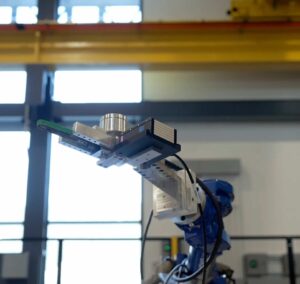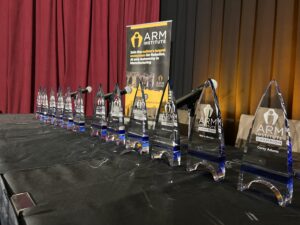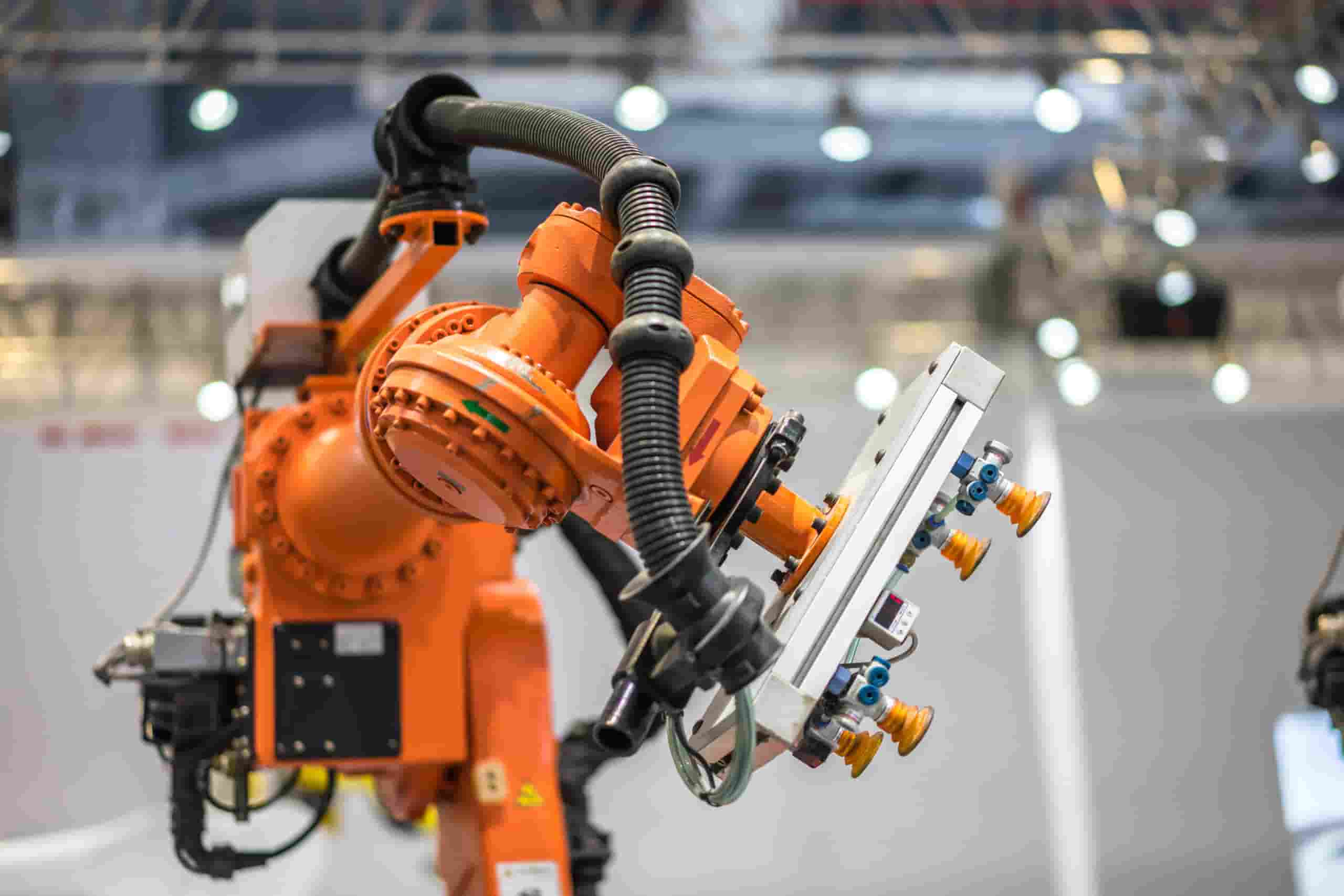
ARM Institute Members are varied in their focus areas, sizes, and history, but one common thread unites each organization: a drive to build the future of US manufacturing. Each member organization of our robotics and AI institute leverages their strengths and areas of expertise to secure a brighter future for the US workforce, a stronger Organic Industrial Base (OIB), and a more resilient manufacturing economy. This impact often involves generating AI solutions for manufacturing.
Artificial intelligence (AI) has been dominating headlines. That’s one reason we launched our three-part summer AI Public Webinar series (more on that here). But AI isn’t a new field for the ARM Institute. Since 2017, we’ve catalyzed countless projects that leverage AI to improve manufacturing consistency and efficiency while minimizing cost. Our Members have been on the forefront of this field alongside us.
In conjunction with our AI webinar series, we’ll also use this summer to highlight our members who offer AI solutions for manufacturing through our Five Question interviews. By demystifying AI best practices, accelerating AI robotic projects, and highlighting companies that are in a prime position to help manufacturers with AI, we take AI out of the theoretical realm and into tangible, practical impact.
For this month’s Five Questions feature, we chatted with Changliu Liu, Associate Professor at the Robotics Institute at Carnegie Mellon University (a core-level ARM Institute Member) and co-founder of Instinct Robotics (a start-up level ARM Member). Changliu has also been recognized as an ARM Institute Champion for going above and beyond to further the ARM Institute’s impact and strengthen US manufacturing.
Instinct Robotics aims to boost productivity and precision with AI-powered robotics for U.S. manufacturing. How do they come to this mission? Part of their journey and initial creation was facilitated through an ARM Institute funded project!
Instinct also recently marked a key milestone by officially moved their headquarters to the third floor of Mill 19. The ARM Institute is co-located on the first and second floors of Mill 19 in Pittsburgh’s Hazelwood neighborhood with Carnegie Mellon University’s Manufacturing Futures Institute and Catalyst Connection, an ARM Institute Member and PA MEP, is located on the third floor of the same building.
Meet Changliu and learn more about Instinct Robotics in the interview below!
1. We always like to start by exploring our expert’s background! Can you tell us about your professional background and your roles both at Instinct Robotics and Carnegie Mellon University?
I am an Associate Professor at the Robotics Institute at Carnegie Mellon University, where I lead the Intelligent Control Lab. My research focuses on intelligent, provably safe, and collaborative robotics, developing control, planning, and learning algorithms that allow robots to operate reliably in complex, uncertain, and human-involved dynamic environments. At CMU, I teach and mentor students across robotics, AI, and control theory, with applications ranging from manufacturing to transportation and logistics.
In parallel, I co-founded Instinct Robotics, a company dedicated to bringing advanced robotics out of the lab and into real-world production. At Instinct, my role bridges deep technical expertise with practical deployment, translating cutting-edge research into robust, commercially viable solutions for intelligent manufacturing. This dual perspective allows me to close the loop between fundamental innovation and industrial impact.
2. Can you tell us about Instinct Robotics and how an ARM Institute project played a role in the creation of Instinct Robotics?
Instinct Robotics was founded to bring two key technological capabilities to manufacturing: fast decision-making and safe execution. Our systems can achieve real-time decision making in complex environments with complex tasks, while satisfying a variety of constraints to significantly improve reliability. Right now, we’re focusing on applying this technology to surface finishing tasks, grinding, deburring, polishing, and related processes, where precision, safety, and adaptability are critical.
The origins of Instinct Robotics trace back to a 2019 ARM Institute-sponsored project, where my research team at Carnegie Mellon worked with Siemens Corporate Technology, Siemens Energy, and Yaskawa to deploy our fast and safe planning and control algorithms on Siemens Energy’s shop floor. The goal was to automate grinding of the interior surface of a turbine transition piece, an extremely challenging geometry that required precise motion planning, safe operation in confined spaces, and consistent quality.
In 2022, the ARM Institute provided a second opportunity to continue this work, this time as a tri-institute collaboration. That support allowed us to mature our technology, validate it in industrial conditions, and significantly improve its TRL level. Those experiences, and the consortium the ARM Institute created, were instrumental in giving us the confidence and the network to launch Instinct Robotics.
3. Instinct Robotics leverages AI-powered robotics. How is an AI-powered robot different from a robot that doesn’t have AI capabilities?
An AI-powered robot is fundamentally different from a traditional robot in two ways.
First, it has flexibility. Instead of following a fixed, pre-programmed path, an AI-powered robot can intelligently adjust its trajectory based on real-time sensing and the specific situation it encounters. This means it can handle variability, whether that’s differences in part geometry, unexpected obstacles, or subtle variations in the workpiece, without requiring a full reprogramming.
Second, it has the ability to continuously improve with data. The more these robots are deployed, the more data they collect, and the smarter they become. Over time, they can refine their performance, optimize processes, and adapt to new tasks more quickly.
At Instinct, our “scan-and-plan” generalist model integrates perception, planning, and reinforcement learning based force control into a single system, allowing it to handle arbitrarily complex part geometries and contact-rich processes, e.g. welding, grinding, polishing, coating, without manual programming or engineering overhead. By combining this with continuous learning, we deliver robotic systems that are both adaptive and reliable, which is essential for high-stakes, high-mix manufacturing environments.
4. Everyone is talking about AI for manufacturing, but usage among manufacturers remains low compared to other industries. Why do you think manufacturers are hesitant to get started with AI-powered robots and what are your tips for those who are looking to get started?

From my experience, there are a few key reasons why manufacturers have been slower to adopt AI-powered robots than other industries.
First, there’s a lack of digitalization in many manufacturing environments. We still see a surprising number of U.S. factories running on paper-based workflows or legacy equipment with minimal sensors. Without a digital backbone, it’s nearly impossible to collect, store, and use the data needed to train or deploy AI models effectively.
Second, there’s a lack of out-of-the-box, ready-to-use foundation models for manufacturing. Even when a model is available, many manufacturers don’t yet have the capability to deploy it—setting up the data infrastructure, training pipelines, and integration with existing systems can be a steep climb.
Third, there’s a lack of certification methods for AI in manufacturing. Reliability is critical, and without a clear way to certify AI methods for safety-critical tasks, adoption naturally moves more slowly.
For those looking to get started, my advice is to focus on high-value pain points where AI can deliver immediate, measurable ROI without disrupting core operations. Begin in areas that are easier to adopt, where foundation models already exist and the task brings high value but is not highly safety-critical. For example, deploying AI-based visual inspection for a single production line can quickly improve defect detection rates without changing the core manufacturing process. In parallel, start building the foundation for future AI use: digitize your processes so data is automatically tracked, and seek out the right partners—people or companies with robotics and AI expertise—to co-develop solutions.
Think of it as “your domain + AI”. Bring your manufacturing knowledge and real-world problems, pair that with AI expertise, and you’ll be much better positioned to deploy AI successfully over time. Treat AI not as a moonshot, but as a series of quick wins that build trust, capability, and a long-term competitive edge.
5. We see that you’re registered to attend our 2025 Annual Member Meeting taking place Sept. 3-5! You were also recognized with an ARM Champion Award at our 2023 Member Meeting for going above and beyond the call of ARM Membership to strengthen US manufacturing. What are you looking forward to in this year’s event and what value you find in participating in our Annual Member Meeting?

I’m especially excited for this year’s Annual Member Meeting, not only because it’s always such a rich learning and networking opportunity, but also because my experience as an ARM Champion in 2023 reminded me how much I value being part of this community. That recognition was truly an honor, and it reinforced how much we can accomplish when members across industry, academia, and government work together.
This meeting is one of the few places where I can engage with the entire consortium: hearing firsthand from manufacturers about their real-world challenges, learning about cutting-edge methods and technologies from fellow researchers, and getting inspired by the creative solutions coming from start-ups.
I also look forward to gaining a better understanding of the strategic priorities the ARM Institute and the government are focusing on. Knowing where the broader vision is headed helps me align both my academic work at CMU and our efforts at Instinct Robotics to have the greatest impact.
For me, the Annual Member Meeting is where inspiration, strategy, and collaboration come together; and that’s what makes it so valuable year after year.
Join Instinct Robotics and our 450+ Member Organization in Building the Future of US Manufacturing
ARM Institute Members lead the way to a future where people and robots work together to respond to our nation’s greatest challenges and to develop and produce the world’s most desired products. By becoming a member of our 450+ member organization consortium, you’ll join thousands of subject matter experts in building the future of US manufacturing through robotics, AI, and workforce innovations. Your membership to our robotics institute unlocks not only access to member-exclusive events and webinars, including our Annual Member Meeting, but also project funding opportunities, project outputs, networking, a digital platform for collaboration, and more.
Explore membership here
ABOUT THE ARM INSTITUTE
The Advanced Robotics for Manufacturing (ARM) Institute is a Manufacturing Innovation Institute (MII) funded by the Office of the Secretary of Defense under Agreement Number W911NF-17-3-0004 and is part of the Manufacturing USA® network. The ARM Institute leverages a unique, robust, and diverse consortium of 450+ members and partners across industry, academia, and government to make robotics, autonomy, and artificial intelligence more accessible to U.S. manufacturers large and small, train and empower the manufacturing workforce, strengthen our economy and global competitiveness, and elevate national security and resilience. Based in Pittsburgh, PA since 2017, the ARM Institute is leading the way to a future where people & robots work together to respond to our nation’s greatest challenges and to produce the world’s most desired products. For more information, visit www.arminstitute.org and follow the ARM Institute on LinkedIn and X (formerly Twitter).
